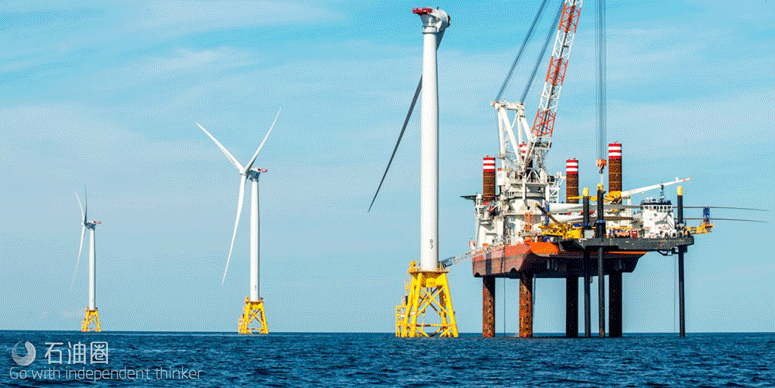
近几年油气前景黯淡,裁员、缩减开支、业务整合……油气大佬们把能想到的办法都试了个遍,如今面对缓慢回升的油价,他们又开始打起了“跨界”的主意。大佬们能否像玩转油气一样,玩转新能源?
作者 | Jessica Shankleman
编译 | 王洋 阿佳徐
近年来,全球可再生能源市场发展迅速,其中尤以风能、太阳能最为引人注目。石油巨头们也在蠢蠢欲动,争相建造海上风电厂,想在新能源领域分一杯羹。
油气巨头——海上风电行业的新星
壳牌、Statoil ASA和Eni SpA正打算将数十亿美元投资于北海和其他海域的海上风力发电厂,他们也正逐渐取代如Dong Energy A/S和Vattenfall AB等传统电力供应商,成为海上风电行业的新星。
油气巨头进军风电行业有很多理由,虽然大佬们已在深水项目领域专研了数十年,但在某些油田老化区,深水项目的发展正逐渐萎缩。而风力发电厂的利润是可预测的,且风电行业受政府监管的电价支撑,所以油企大力发展风电产业也在情理之中。
Eni能源解决方案副总裁Luca Cosentino表示,“风力发电和传统油气业有明显的协同作用,我们对该领域很感兴趣,目前也正与GE合作,共同开发新能源领域,油气行业不能固步自封,坐等别人来超越我们”。
在过去15年中,北海地区的产油量有所下降,该地区的经济发展也逐渐开始靠海上风力发电支撑。现如今,油企大力发展风电产业,除了本职工作,平台钻工们还需对海上风电涡轮机进行安装和维护,如此一来,曾经一度威胁海工生存的风电产业也变为新一代钻工的福利。
据彭博社新能源财经统计,在2000-2017年间,北海风电项目的投资额约达到990亿美元,而在十年前,风电产业的版图只有那么一丁点大!
风能、太阳能等新能源正逐渐抑制石油需求增长,虽然目前原油仍占全球能源供应需求的三分之一,但油气巨头们早已在新能源路上做好了打算。
据新能源财经表示,到2040年,电动汽车和新能源技术可能将取代多达1300万桶/天的全球能源需求,这甚至超过了沙特当前的石油日产量。
这里是壳牌的兴趣所在
壳牌CEO Ben van Beurden曾表示,石油峰值也许会在10年后到来,对此,壳牌已成立了新业务单元,以确保清洁技术的利润最大化。
壳牌英国业务总裁Sinead Lynch在采访中表示,壳牌对风力发电厂很感兴趣,因为其能电解制氢,而壳牌认为,未来数十年,氢可能将成为汽车的主要燃料。
在去年12月与荷兰政府签订Borssele 3号、4号风力发电厂建造合同后,壳牌便开始在整个欧洲大陆发掘清洁能源的新机遇。Lynch表示,“油气巨头在营销方面的专业性会使其在新能源领域具有绝对优势。风电行业也需要专业的营销,一旦电能产生,公司就需要经营,因此,营销和贸易的幕后支撑也是企业发展新能源必不可少的。
Statoil降低成本 力争风电No.1
Statoil高级副总裁Stephen Bull表示,油气巨头正设法通过降低生产成本来改变海上风电产业。
Bull称,Statoil位于英格兰东海岸的Dudgeon风电厂生产成本要比六年前附近建造的风电厂成本下降40%,且新创的海上浮式风电基础也省略了深海固定风车桅杆等成本高昂的步骤。目前除了英国,公司也在德国和挪威开发新项目,并于去年12月在纽约成功中标建造海上风电厂项目。
据新能源财经表示,削减海上风电成本能够帮助新能源技术与传统形式能源竞争,尤其是在核裂变反应发电方面。伦敦总部的研究人员称,得益于激烈竞争和大容量风电机组,当前风电项目的发电成本约仅为2012年发电成本的一半,到2035年,风电生产成本可能会再降26%左右。
英国绿色投资银行海上风电主管Nick Gardiner表示,如壳牌、Eni这等规模的集团能提供比其他竞争对手更低廉的生产成本,他们在该领域占据着绝对优势,且油气巨头进入新能源领域是一种“长期趋势”。
瑞典Vattenfall AB是全球五大海上风电开发商之一,该公司风电主管Gunnar Groebler表示,“我不认为油气巨头关注新能源领域仅仅是出于投资的目的,考虑到这些数十亿欧元的投资项目,我认为他们已经做了非常全面的评估。”
GE也来分一杯羹
新晋油气巨头GE去年也以16.5亿美元收购丹麦风力涡轮机制造商LM风力发电公司,以巩固其可再生能源领域的业务。GE项目相关负责人表示,此项交易收购了LM旗下的13家工厂,该收购项目将于2017年上半年完成,并于2018年底正式运营,LM风电公司将作为GE的独立业务部门。GE是全球排名前三的风电整机制造商,该公司一直在寻求进一步提升海上风电实力,增强与西门子、维斯塔斯等风电巨头的竞争优势。
BP也曾表示,“能源结构向低碳方向转型是大势所趋,不过,石油变成‘夕阳’行业至少也得是半个世纪以后的事”。目前来看,各大油企都在为半个世纪后到来的“夕阳”做准备。未雨绸缪,巨头之所以能成为巨头,大概就是这个道理吧!
Royal Dutch Shell Plc, Statoil ASA and Eni SpA are moving into multi-billion-dollar offshore wind farms in the North Sea and beyond. They’re starting to score victories against leading power suppliers including Dong Energy A/S and Vattenfall AB in competitive auctions for power purchase contracts, which have developed a specialty in anchoring massive turbines on the seabed.
The oil companies have many reasons to move into the industry. They’ve spent decades building oil projects offshore, and that business is winding down in some areas where older fields have drained. Returns from wind farms are predictable and underpinned by government-regulated electricity prices. And fossil fuel executives want to get a piece of the clean-energy business as forecasts emerge that renewables will eat into their market.
“It is certainly an area of interest for us because there are obvious synergies with the traditional oil and gas business,” said Luca Cosentino, the vice president of energy solution at the Italian oil producer Eni, which is working with General Electric Co. on renewables. “As the oil and gas industry we know, we cannot get stuck where we are and wait for someone else to take this leap.”
Even as oil production declined in the North Sea over the last 15 years, economic activity has been buoyed by offshore windmills. The notorious winds that menaced generations of roughnecks working on oil platforms have become a boon for a new era of workers asked to install and maintain turbines anchored deep into the seabed. About $99 billion will be invested in North Sea wind projects from 2000 to 2017, according to Bloomberg New Energy Finance. A decade ago, the industry had projects only a fraction of that size.
While crude still supplies almost a third of the world’s energy, oil executives are starting to adjust to demands for cleaner fuels. Even so, emerging fossil-fuel alternatives including wind and solar power are starting to limit growth in oil demand.
Those technologies and electric cars may displace as much as 13 million barrels of oil a day from global demand by 2040, more than is currently being produced by Saudi Arabia, according to Bloomberg New Energy Finance.
Shell, whose CEO Ben van Beurden has said oil demand may peak in the second half of the next decade, has set up a business unit to identify the clean technologies where it could be most profitable. The company began more than 180 years ago importing shells from Asia and needs to adapt to ensure it’s still around in another century, according to Sinead Lynch, the company’s chair for U.K. businesses.
Wind farms are especially interesting to Shell because they can power electrolysis reactions that make hydrogen, which the company says may be a major fuel for cars in the coming decades, said Lynch in an interview.
It’s exploring new opportunities across Europe in offshore wind after winning contracts from the Dutch government to build the Borssele III and IV wind farms in December. Shell’s bid marked the second cheapest cost for the technology worldwide, according to Lynch, who said the oil major’s big advantage in renewables may be its expertise in marketing.
“It’s also about marketing energy,” Lynch said. “Once you produce your wind, you need to market the power and we have a phenomenally strong marketing and trading business.”
Statoil’s Costs
Oil majors are also changing the offshore wind industry by driving down costs, Statoil Senior Vice President Stephen Bull wrote in an email.
The Norwegian oil major’s Dudgeon wind farm off England’s east coast will be 40 percent cheaper than a neighboring plant built six years ago, Bull said. It’s also creating floating offshore wind foundations that eliminate the costly step of anchoring windmill masts into the seabed. In addition to the U.K., the company is developing projects in Germany and Norway and won a December auction to build an offshore wind farm in New York.
Cost cuts for offshore wind are helping the technology start to compete with traditional forms of energy, especially nuclear, according to Bloomberg New Energy Finance. Current projects entering operation are delivering power at about half the price of farms finished in 2012 thanks to larger turbines and more competition. Costs could fall another 26 percent by 2035, according to the London-based researcher.
The entry of oil majors into renewables is part of “a longer term trend,” according to Nick Gardiner, head of offshore wind at U.K. Green Investment Bank, who notes that companies with the scale of Shell and Eni have the clout to finance projects more cheaply than many of their competitors.
“I don’t think they are doing this just for investor-relation purposes,” said Gunnar Groebler, head of wind at Sweden’s Vattenfall AB, one of the top five offshore wind developers who welcomed the added competition. “Given that these projects are billion-euro investments, I just assume that they will have done their assessments very thoroughly.”
未经允许,不得转载本站任何文章:
-

- 阿佳徐
-
石油圈认证作者
- 毕业于黑龙江大学英语口译专业,具有丰富的翻译工作经验。致力于观察国际油气行业动态,能够快速、准确传递油气行业最新资讯,提供丰富的油气信息,把握行业动向,为国内企业提供专业的资讯服务。(QQ:348418756)


 石油圈
石油圈
